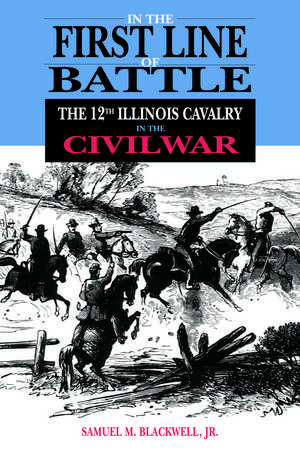In the First Line of Battle: The 12th Illinois Cavalry in the Civil War
Autor Samuel M. Blackwell, Jr.en Limba Engleză Hardback – 30 noi 2001
From its first major engagement at Harpers Ferry, Virginia, to the campaigns against Confederates in the swamps of occupied Louisiana, the 12th Illinois Volunteer Cavalry fought more than twenty battles in three theaters of combat. So great was the regiment's contribution to the Union victory that a monument at Gettysburg honors the unit for its place "in the first line of battle."
The campaigns of the 12th Illinois reflect the larger shape of the war. In 1862 and early 1863, the 12th Illinois defended Union supply lines against the lightning raids of J. E. B. Stuart's Confederate Cavalry in Virginia and Maryland. In 1863, it helped to turn back the tide of the Confederate advance at Gettysburg. And in 1864–1865 the unit went on the offensive and raided deep into the Southern heartland as the Union pursued a strategy of "hard war."
Drawing upon firsthand accounts from letters, diaries, memoirs, and official service records, Blackwell brings the soldiers of the 12th Illinois to life. As with other militia units in the heady first months of the war, the 12th Illinois assembled quickly, and its officers had at best only rudimentary military training. They were little prepared for the rigors of leading men into war or coping with desertions and horrific casualties.
In the First Line of Battle tells the story of how the 12th Illinois Cavalry came through the war with its colors intact. Tracking the regiment from its first muster early in 1862 through its service in Texas during Reconstruction, Blackwell shows readers the war as it was lived by men who fought across the length and breadth of the Confederacy. Tracing the path of the 12th Illinois, he sheds new light on the role of the Union cavalry in the Civil War.
The campaigns of the 12th Illinois reflect the larger shape of the war. In 1862 and early 1863, the 12th Illinois defended Union supply lines against the lightning raids of J. E. B. Stuart's Confederate Cavalry in Virginia and Maryland. In 1863, it helped to turn back the tide of the Confederate advance at Gettysburg. And in 1864–1865 the unit went on the offensive and raided deep into the Southern heartland as the Union pursued a strategy of "hard war."
Drawing upon firsthand accounts from letters, diaries, memoirs, and official service records, Blackwell brings the soldiers of the 12th Illinois to life. As with other militia units in the heady first months of the war, the 12th Illinois assembled quickly, and its officers had at best only rudimentary military training. They were little prepared for the rigors of leading men into war or coping with desertions and horrific casualties.
In the First Line of Battle tells the story of how the 12th Illinois Cavalry came through the war with its colors intact. Tracking the regiment from its first muster early in 1862 through its service in Texas during Reconstruction, Blackwell shows readers the war as it was lived by men who fought across the length and breadth of the Confederacy. Tracing the path of the 12th Illinois, he sheds new light on the role of the Union cavalry in the Civil War.
Preț: 359.85 lei
Nou
Puncte Express: 540
Preț estimativ în valută:
68.86€ • 75.03$ • 58.02£
68.86€ • 75.03$ • 58.02£
Carte tipărită la comandă
Livrare economică 23 aprilie-07 mai
Preluare comenzi: 021 569.72.76
Specificații
ISBN-13: 9780875802794
ISBN-10: 0875802796
Pagini: 240
Dimensiuni: 152 x 229 x 23 mm
Greutate: 0.54 kg
Ediția:1
Editura: Northern Illinois University Press
Colecția Northern Illinois University Press
ISBN-10: 0875802796
Pagini: 240
Dimensiuni: 152 x 229 x 23 mm
Greutate: 0.54 kg
Ediția:1
Editura: Northern Illinois University Press
Colecția Northern Illinois University Press
Recenzii
"A genuine contribution to the history of the Union cavalry."—Michigan Historical Review
"Blackwell's research and care of the subject is great.... One realizes and appreciates the efforts of the real-life men in the glorious, mundane, and fearful aspects of the war"—Journal of Illinois History
"Blackwell's research and care of the subject is great.... One realizes and appreciates the efforts of the real-life men in the glorious, mundane, and fearful aspects of the war"—Journal of Illinois History
Notă biografică
Samuel M. Blackwell Jr. is visiting Assistant Professor of History at Northern Illinois University.
Cuprins
Table of Contents
List of Maps
Introduction
1. "Rally 'round the Flag"
2. "Drop Carbines!... Draw Sabres!... Charge!"
3. "Picket and Reconnaissance Duty"
4. Raids
5. Forcing the Rebels to Deploy
6. "Fighting the Rebs for Seven Days"
7. Search and Destroy
8. From Tennessee to Texas
9. Reconstruction in a Conquered Land
Epilogue: Sound Taps
Appendix: 12th Illinois Volunteer Cavalry
Notes
Bibliography
Index
Introduction
1. "Rally 'round the Flag"
2. "Drop Carbines!... Draw Sabres!... Charge!"
3. "Picket and Reconnaissance Duty"
4. Raids
5. Forcing the Rebels to Deploy
6. "Fighting the Rebs for Seven Days"
7. Search and Destroy
8. From Tennessee to Texas
9. Reconstruction in a Conquered Land
Epilogue: Sound Taps
Appendix: 12th Illinois Volunteer Cavalry
Notes
Bibliography
Index
Descriere
From its first major engagement at Harpers Ferry, Virginia, to the campaigns against Confederates in the swamps of occupied Louisiana, the 12th Illinois Volunteer Cavalry fought more than twenty battles in three theaters of combat. So great was the regiment's contribution to the Union victory that a monument at Gettysburg honors the unit for its place "in the first line of battle."
The campaigns of the 12th Illinois reflect the larger shape of the war. In 1862 and early 1863, the 12th Illinois defended Union supply lines against the lightning raids of J. E. B. Stuart's Confederate Cavalry in Virginia and Maryland. In 1863, it helped to turn back the tide of the Confederate advance at Gettysburg. And in 1864–1865 the unit went on the offensive and raided deep into the Southern heartland as the Union pursued a strategy of "hard war."
Drawing upon firsthand accounts from letters, diaries, memoirs, and official service records, Blackwell brings the soldiers of the 12th Illinois to life. As with other militia units in the heady first months of the war, the 12th Illinois assembled quickly, and its officers had at best only rudimentary military training. They were little prepared for the rigors of leading men into war or coping with desertions and horrific casualties.
In the First Line of Battle tells the story of how the 12th Illinois Cavalry came through the war with its colors intact. Tracking the regiment from its first muster early in 1862 through its service in Texas during Reconstruction, Blackwell shows readers the war as it was lived by men who fought across the length and breadth of the Confederacy. Tracing the path of the 12th Illinois, he sheds new light on the role of the Union cavalry in the Civil War.
The campaigns of the 12th Illinois reflect the larger shape of the war. In 1862 and early 1863, the 12th Illinois defended Union supply lines against the lightning raids of J. E. B. Stuart's Confederate Cavalry in Virginia and Maryland. In 1863, it helped to turn back the tide of the Confederate advance at Gettysburg. And in 1864–1865 the unit went on the offensive and raided deep into the Southern heartland as the Union pursued a strategy of "hard war."
Drawing upon firsthand accounts from letters, diaries, memoirs, and official service records, Blackwell brings the soldiers of the 12th Illinois to life. As with other militia units in the heady first months of the war, the 12th Illinois assembled quickly, and its officers had at best only rudimentary military training. They were little prepared for the rigors of leading men into war or coping with desertions and horrific casualties.
In the First Line of Battle tells the story of how the 12th Illinois Cavalry came through the war with its colors intact. Tracking the regiment from its first muster early in 1862 through its service in Texas during Reconstruction, Blackwell shows readers the war as it was lived by men who fought across the length and breadth of the Confederacy. Tracing the path of the 12th Illinois, he sheds new light on the role of the Union cavalry in the Civil War.













